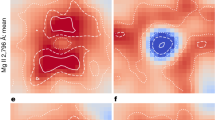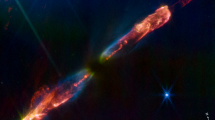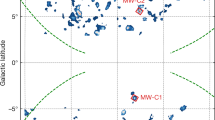Abstract
The BN/KL region in the Orion molecular cloud1 is an archetype for the study of the formation of stars much more massive than the Sun2. This region contains luminous young stars and protostars but, like most star-forming regions, is difficult to study in detail because of the obscuring effects of dust and gas. Our basic expectations are shaped to some extent by the present theoretical picture of star formation, the cornerstone of which is that protostars accrete gas from rotating equatorial disks and shed angular momentum by ejecting gas in bipolar outflows. The main source of the outflow in the BN/KL region3,4,5 may be an object known as radio source I (ref. 6), which is commonly believed to be surrounded by a rotating disk of molecular material7,8,9. Here we report high-resolution observations of silicon monoxide (SiO) and water maser emission from the gas surrounding source I. We show that within 60 AUof the source (about the size of the Solar System), the region is dominated by a conical bipolar outflow, rather than the expected disk. A slower outflow, close to the equatorial plane of the protostellar system, extends to radii of 1,000 AU.
This is a preview of subscription content, access via your institution
Access options
Subscribe to this journal
Receive 51 print issues and online access
$199.00 per year
only $3.90 per issue
Buy this article
- Purchase on Springer Link
- Instant access to full article PDF
Prices may be subject to local taxes which are calculated during checkout

Similar content being viewed by others
References
Kleinmann, D. E. & Low, F. J. Discovery of an infrared nebula in Orion. Astrophys. J. 149, L1–L4 (1967).
Genzel, R. & Stutzki, J. The Orion molecular cloud and star-forming region. Annu. Rev. Astron. Astrophys. 27, 41–85 (1989).
Gezari, D. Y. Mid-infrared imaging of Orion BN/KL: astrometry of IRc2 and the SiO maser. Astrophys. J. 396, L43–L47 (1992).
Gezari, D. Y. & Backman, D. E. 4.8–20 micron imaging of Orion BN/KL: II. A new look at luminosity sources and the role of IRc2. Astrophys. Space Sci. 224, 45–52 (1995).
Menten, K. M. & Reid, M. J. What is powering the Orion Kleinmann-Low infrared nebula? Astrophys. J. 445, L157–L160 (1995).
Churchwell, E., Wood, D. O. S., Felli, M. & Massi, M. Solar system-sized condensations in the Orion nebula. Astrophys. J. 321, 516–519 (1987).
Plambeck, R. L., Wright, M. C. H. & Carlstrom, J. E. Velocity structure of the Orion-IRc2 SiO maser: evidence for an 80 AU diameter circumstellar disk. Astrophys. J. 348, L65–L68 (1990).
Wright, M. C. H., Plambeck, R. L., Mundy, L. G. & Looney, L. W. SiO emission from a 1,000 AU disk in Orion KL. Astrophys. J. 455, L185–L188 (1995).
Barvainis, R. The polarization of the SiO masers in Orion: maser emission from a rotating, expanding disk? Astrophys. J. 279, 358–362 (1984).
Thronson, H. A. J et al. The Orion star-forming region: far-infrared and radio molecular observations. Astron. J. 91, 1350–1356 (1986).
Wright, M. C. H., Plambeck, R. L. & Wilner, D. J. Amultiline aperture synthesis study of Orion-KL. Astrophys. J. 469, 216–237 (1996).
Genzel, R., Reid, M. J., Moran, J. M. & Downes, D. Proper motions and distances of H2O maser sources. I. The outflow in Orion-KL. Astrophys. J. 244, 884–902 (1981).
Allen, D. A. & Burton, M. G. Explosive ejection of matter associated with star formation in the Orion nebula. Nature 363, 54–56 (1993).
Jones, B. F. & Walker, M. F. Proper motions of Herbig-Haro objects. VI. The M42 HH objects. Astron. J. 90, 1320–1323 (1985).
Plambeck, R. L., Wright, M. C. H., Mundy, L. G. & Looney, L. W. Subarcsecond-resolution 86 GHz continuum maps of Orion KL. Astrophys. J. 455, L189–L192 (1995).
Morita, K.-I., Hasegawa, T., Ukita, N., Okumura, S. K. & Ishiguro, M. Accurate positions of SiO masers in active star forming regions: Orion-KL, W51-IRS2, and Sgr-B2 MD5. Publ. Astron. Soc. Jpn 44, 373–380 (1992).
Torrelles, J. M. et al. Radio continuum-H2O maser systems in NGC 2071: H2O masers tracing a jet (IRS 1) and a rotating proto-planetary disk of radius 20 AU (IRS 3). Astrophys. J. 505, 756–765 (1998).
Zensus, J. A., Diamond, P. J. & Napier, P. J. (eds) Very Long Baseline Interferometry and the VLBA (Astron. Soc. Pacific, San Francisco, 1995).
Gaume, R. A., Wilson, T. L., Vrba, F. J., Johnston, K. J. & Schmid-Burgk, J. Water masers in Orion. Astrophys. J. 493, 940–949 (1998).
Sugai, H. et al. Velocity field of the Orion-KL region in molecular hydrogen emission. Astrophys. J. 442, 674–678 (1995).
Migenes, V., Johnston, K. J., Pauls, T. A. & Wilson, T. L. The distribution and kinematics of ammonia in the Orion-KL nebula: high-sensitivity VLA maps of the NH3(3,2) line. Astrophys. J. 347, 294–301 (1989).
Greenhill, L. J. et al. in The Impact of VLBI on Astrophysics and Geophysics (eds Reid, M. J. & Moran, J. M.) 253–254 (Kluwer, Dordrecht, 1988).
Hu, X. Kinematic studies of Herbig-Haro objects in the Orion nebula. Astron. J. 112, 2712–2717 (1996).
Chandler, C. J. & De Pree, C. G. Vibrational ground-state SiO J = 1–0 emission in Orion IRc2 imaged with the VLA. Astrophys. J. 455, L67–L71 (1995).
Lucas, R. et al. Interferometric observations of SiO v = 0 thermal emission from evolved stars. Astron. Astrophys. 262, 491–500 (1992).
Danchi, W. C., Bester, M., Degiacomi, C. G., Greenhill, L. J. & Townes, C. H. Characteristics of dust shells around 13 late-type stars. Astron. J. 107, 1469–1513 (1994).
Dougados, C., Lena, P., Ridgway, S. T., Christou, J. C. & Probst, R. G. Near-infrared imaging of the Becklin-Neugebauer-IRc2 region in Orion with subarcsecond resolution. Astrophys. J. 406, 112–121 (1993).
Schleuning, D. A. Far-infrared and submillimeter polarization of OMC-1: evidence for magnetically regulated star formation. Astrophys. J. 493, 811–825 (1998).
Rao, R., Crutcher, R. M., Plambeck, R. L. & Wright, M. C. H. High-resolution millimeter-wave mapping of linearly polarized dust emission: magnetic field structure in Orion. Astrophys. J. 502, L75–L78 (1998).
Shu, F. H., Najita, J., Ostriker, E. C. & Shang, H. Magnetocentrifugally driven flows from young stars and disks. V. Asymptotic collimation into jets. Astrophys. J. 455, L155–L158 (1995).
Wardle, M. & Königl, A. The structure of protostellar accretion disks and the origin of bipolar flows. Astrophys. J. 410, 218–238 (1993).
Garay, G., Moran, J. M. & Haschick, A. D. The Orion-KL super water maser. Astrophys. J. 338, 244–261 (1989).
Acknowledgements
We thank M. Reid for assistance in recovering his VLA data, and C. Dougados and K.Menten for permission to use the infrared and radio images presented in Fig. 2 . The National Radio Astronomy Observatory is a facility of the US NSF operated under cooperative agreement by Associated Universities, Inc. C.S. was supported by the NSF REU program. C.R.G. was supported by the NSF Stellar Astronomy and Astrophysics program.
Author information
Authors and Affiliations
Corresponding author
Rights and permissions
About this article
Cite this article
Greenhill, L., Gwinn, C., Schwartz, C. et al. Coexisting conical bipolar and equatorial outflows from a high-mass protostar. Nature 396, 650–653 (1998). https://doi.org/10.1038/25299
Received:
Accepted:
Issue Date:
DOI: https://doi.org/10.1038/25299
This article is cited by
-
A rotating protostellar jet launched from the innermost disk of HH 212
Nature Astronomy (2017)
-
The formation of a massive protostar through the disk accretion of gas
Nature (2004)
Comments
By submitting a comment you agree to abide by our Terms and Community Guidelines. If you find something abusive or that does not comply with our terms or guidelines please flag it as inappropriate.




